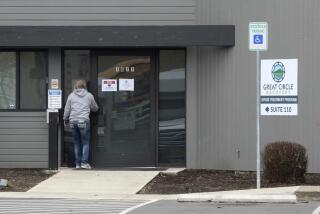The Problem Is Prohibition . . . : The lessons of alcohol dictate, if not legalization, at least a relaxed enforcement as in Europe and Australia.
- Share via
Almost everyone acknowledges it privately, but few politicians will say publicly that the war on drugs cannot be won. In 1988, Congress adopted a resolution declaring its intention that the United States be drug-free by 1995. It’s 1996, and there are more drugs than before. Drugs are here to stay. The challenge is not how to become a drug-free society or even how to reduce drug use as much as possible. Rather, the challenge is to learn how to live with drugs so that they cause the least possible harm.
We have to start talking honestly and openly about America’s most serious drug problem, which is prohibition. It has been and will always be the case that most Americans who use drugs do so responsibly and in moderation, while a small minority do so in ways that harm themselves and others. Drug prohibition laws certainly deter some people from using drugs and thereby prevent a minority of them from becoming drug addicts. But all the evidence available indicates that most Americans do not need prohibition laws to save them from addiction, and for those who use drugs anyway, prohibition laws do more harm than good.
The American experience with alcohol prohibition provides important lessons for analyzing our current predicament. A constitutional amendment outlawing alcohol was passed in 1919 because Americans believed it would eliminate alcohol consumption and its ills. They soon saw their hopes dashed. Alcohol consumption fell at first, assisted by a powerful temperance movement that helped persuade many Americans to stop drinking, but then reversed course. Americans realized that no prohibition law could dissuade millions from drinking if they really wanted to.
At the same time, Americans witnessed rising levels of organized crime and corruption, overflowing jails and courthouses, violent struggles among bootleggers and rumrunners, increasing lawlessness, the labeling of millions as criminals and even the poisoning of hundreds of thousands of people by bad homemade liquor. These were not simply “alcohol problems”; they were the consequences of prohibition.
Americans need to make that same distinction today. The diversion of substantial police, judicial and prison resources to arresting, prosecuting and incarcerating millions of drug users and hundreds of thousands of drug dealers, at an annual cost of tens of billions of dollars, is not simply a drug problem but a drug prohibition problem. When drug dealers kill one another as well as innocent bystanders, witnesses and police officers, that’s a prohibition problem. When drug addicts steal or prostitute themselves to support drug habits made more expensive because they have to obtain their drugs in the black market, that’s a prohibition problem as well. And when addicts spread the HIV virus because sterile syringes are not legally and readily available, that too is a direct result of prohibition.
Distinguishing between the harmful consequences of drug use and the harmful consequences of prohibition is the crucial first step toward a more effective policy for dealing with drugs. The alternatives are far more varied than simple repeal of prohibition or legalization.
We can learn from Europe and Australia, where governments are trying to reduce the negative consequences of both drug use and drug prohibition. In the Netherlands, illicit cannabis markets are regulated and controlled by the police as if they were legal. As for Ecstasy, Dutch health officials worry more about kids getting a bad dose than about their getting the real thing. Switzerland has experimented with prescribing heroin to hundreds of addicts; their health and well-being improved dramatically. Some have found jobs. There have been no overdoses and virtually no problem with diversion of drugs to the black market. The experiment also destroyed a host of myths about heroin addiction, starting with the notion that there’s no limit to the amount of heroin an addict will consume if given the opportunity.
The United States cannot and should not be a drug-free society. The only viable policy in the foreseeable future is one that accepts that drugs are here to stay, that distinguishes between the problems of drug abuse and the problems of drug prohibition and that seeks to reduce both types of problems sensibly and humanely.
More to Read
Sign up for Essential California
The most important California stories and recommendations in your inbox every morning.
You may occasionally receive promotional content from the Los Angeles Times.












